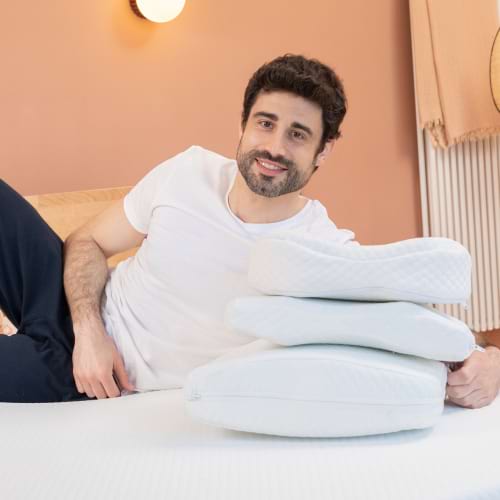
Sciatica
Sciatica is where the sciatic nerve, which runs from your lower back to your feet, is irritated or compressed. Pain can be felt along the length of the sciatic nerve, however it typically only affects one side of the body. How can you recognise sciatica and what should you do during a painful episode?
- 1. What is sciatica?
- 2. What are the causes and symptoms of sciatica?
- 3. Treatment and prevention of sciatica
- 4. PERCKO, a long-term complementary solution

1. What is sciatica?
The sciatic nerve is the largest nerve of the human body. It serves a vital role in connecting the spinal cord with the lower limbs and controls the articulations of the hips, knees and ankles, as well as the muscles of the thighs, legs and feet. The sciatic nerve emerges from the spinal cord at the level of the fifth lumbar vertebra (L5 and S1) before descending into the buttock, the thigh and finally dividing into multiple branches which innervate the different areas of the lower limb.
Sciatica occurs when something presses or rubs on the sciatic nerve. This causes inflammation, pain or even numbness in the lower limb. Sciatica usually only occurs in one leg although it can occur in both.
Sciatica is therefore a warning sign that something is wrong with your lower back.
2. What are the causes and symptoms of sciatica?
Causes of sciatica include:
- Slipped disc (the most common cause) – when a soft cushion of tissue between the bones in your spine pushes out
- Spinal stenosis – narrowing of the part of your spine where nerves pass through
- Spondylolisthesis – when one of the bones in your spine slips out of position
- Back injury
The main symptom is pain, which may occur in the lower back, buttock, posterior or lateral thigh, knee, lateral leg and up to the big toe.
The pain may be accompanied by numbness in the buttock or lower limb, tingling, burning, pins and needles, loss of feeling or muscle strength. It can occur intermittently or continuously, and varies between individuals and the degree of irritation of the sciatic nerve.
3. Treatment and prevention of sciatica
How you can ease the pain yourself
Sciatica usually gets better in 4 to 6 weeks, but it can sometimes last longer. To help relieve your pain and speed up recovery:
- Carry on with your normal activities as much as possible
- Regular exercises for sciatica
- Start gentle exercise as soon as you can – anything that gets you moving can help
- Hold heat packs to the painful areas – you can buy these from pharmacies
- Ask your pharmacist about painkillers – NSAIDs like ibuprofen are often recommended – paracetamol on its own is unlikely to relieve your pain
- Put a small, firm cushion between your knees when sleeping on your side, or several firm pillows underneath your knees when lying on your back
- Do not sit or lie down for long periods – even if moving hurts, it's not harmful and can help you get better faster
- Do not use hot water bottles to ease the pain – you could scald yourself if your skin is numb
Treatments from a GP
If you have sciatica, and the pain has not improved after trying home treatments for a few weeks, is getting worse or is stopping you doing your normal activities, the GP may:
- Suggest exercises and stretches
- Prescribe painkillers that help with nerve pain like sciatica
They might also refer you for:
- Physiotherapy – including exercise advice and techniques like massage (manual therapy)
- Psychological support – to help you cope with the pain
Physiotherapy is free of charge on the NHS throughout the UK, but waiting times can be long. You can also get it privately.
Other treatments for sciatica
If your pain is very bad and treatments from a GP have not helped, they may refer you to a hospital specialist for:
- Painkilling injections
- A procedure to seal off some of the nerves in your back so they stop sending pain signals
- Surgery – an operation called decompression surgery can sometimes help relieve sciatica
How to stop sciatica coming back
To reduce the chances of getting sciatica again:
- Stay active – take regular exercise
- Use a safe technique when lifting heavy objects
- Make sure you have a good posture when sitting and standing
- Sit correctly when using a computer
- Lose weight if you're overweight
- Do not smoke – smoking can increase your risk of getting sciatica
Information from the NHS website
4. Percko, a long-term complementary solution
In the treatment and prevention of sciatica, maintaining mobility and a healthy posture is key. These treatment methods address the most common cause of sciatica which is a slipped disc.
PERCKO products use Lyne technology to help prevent slipped discs by:
- Encouraging the user to avoid long periods in static/slouched positions. By maintaining mobility in the back, pressure is more evenly distributed throughout the spine and the discs themselves.
- Keeping the user mobile, engaging the core and strengthening the back muscles. This helps the spine maintain a better curvature which improves the ability of the discs to absorb shocks from daily activities.
Developed and patented by PERCKO, Lyne technology is an elasticated system of tenors which apply pressure to the shoulders and the lower back. The elasticated system of tensors provides a gentle reminder, through a feeling of resistance, to the user to adopt a healthier posture whenever they begin to slouch. It is firmly based on the understanding that a user must retain a certain level of autonomy in the process of maintaining a healthy back. This sets PERCKO products apart from lumbar belts, which leave no autonomy to the wearer and can actually cause the muscles to atrophy instead of strengthening them.
Lyne technology, built into all PERCKO T-shirts and vests, is the result of continuous research and development carried out since 2014 alongside a team of experts in biomechanics, physiotherapists and osteopaths.
All products in the Lyne range are certified medical devices. They were developed in France and are currently recommended by over 1,700 health professionals, including physiotherapists, osteopaths and work ergonomists.
To choose the right Lyne product for you, click here.
Information from the NHS website is licensed under the Open Government Licence v3.0.



